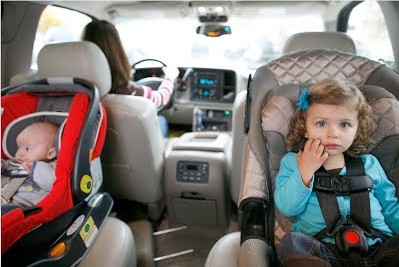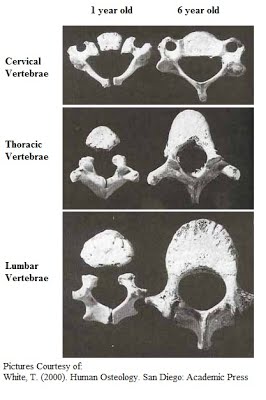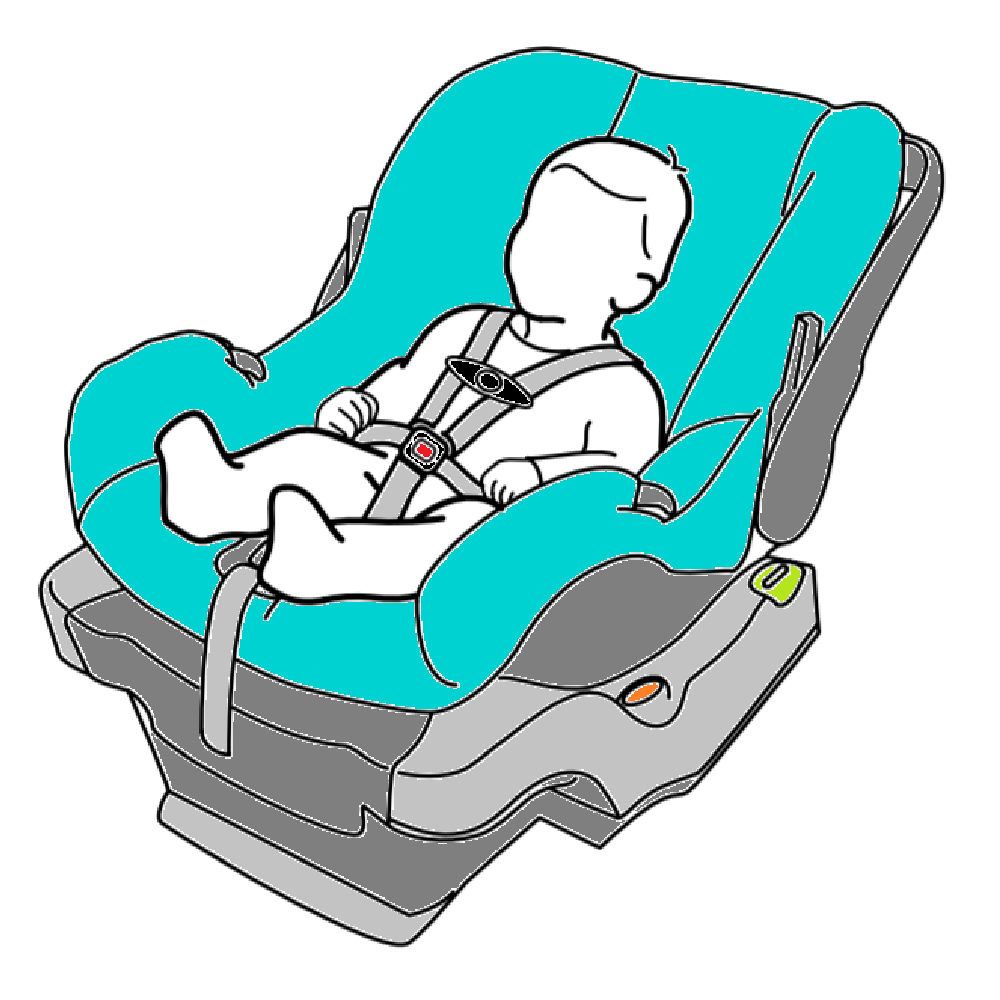Rear Facing 101
Basics, Science, Crash Dynamics, Videos, FAQs
Rear-Facing Basics
Rear facing is the safest way for children to travel. It is the best way to prevent head and spinal injuries.
A child should ride in a rear-facing car seat AS LONG AS POSSIBLE, up to the limits of their convertible car seat. This includes virtually all children under 2 years of age and most children up to age 4.
As per AAP (American Academy of Pediatrics), it is best practice to rear-face ideally until the child reaches the top height or weight limit allowed by the car seat manufacturer.

- 1. Rear Facing Basics
- 2. Proper Rear-Facing Car Seat Use
- 3. Crash Dynamics: Rear-facing vs. Forward-Facing
- 4. The Anatomical Science of Rear-Facing
- 5. The legs are touching the vehicle seat? Is it safe?
- 6. Is the positioning of the legs uncomfortable for the child?
- 7. I want to see my child. What are my options?
- 8. What if I am rear-ended? Is it safer forward-facing?
- 9. What about side impact collisions? Does it make a difference?
- 10. Rear-Facing Videos
Using a Rear-Facing Car Seat Correctly
A rear-facing car seat is only safe when used correctly.
- Position harness straps at or below shoulders for rear-facing.
- Position chest clip at armpit level. Harness must be tightened snugly.
- Install seat at the correct angle and through the correct belt path as per instructions.
- Child should have no less than 1″ of car seat shell above their head (unless otherwise specified in the manual)
- Car seat should be installed with LATCH or Seat Belt, Never both (unless otherwise specified by car seat and vehicle manufacturers)
- Car seat should be installed with no more that 1″ of movement side-to-side or front-to-back at the belt path, with LATCH or locked seat belt.
- **Refer to the vehicle and car seat manuals for specific installation requirements and safety information.**
Crash Dynamics
Point of Impact
During a crash, everything (including the occupants) will travel towards the point of impact.
According to NHTSA, frontal or offset frontal vehicle crashes make up the majority of all collisions. Rear-end crashes are also common, however, they comprise of much smaller percentage of all severe collisions, suggesting that while numerous, rear-end crashes are not especially traumatic.
This places much of the crash dynamics emphasis on frontal collisions. Rear-facing car seats may not work as effectively in a rear impact, however frontal, frontal offset and side impacts are not only more common, but also account for the most percentage of fatalities.
Read on to learn why the point of impact is so important in rear-facing occupant protection.
3 types of ”Crashes”
Every collision includes three crashes:
- The vehicle crash – the vehicle strikes something and comes to a complete stop. The crushing of the vehicle absorbs some of the crash forces.
- The human crash – when the vehicle comes to a stop, the human body continues to move toward the point of impact at the vehicle’s original speed. The passenger then collides with something that brings the body to a complete stop – such as the harness, seat belt, airbag, or the back of the car seat.
- The internal crash – when the occupant’s body comes to a complete stop, the internal organs are still moving forward, until striking the inside of the body.
Crash Forces
The amount of restraining force required to bring an occupant to a stop is a factor of the occupant’s weight and speed of travel.
The force needed to restrain an occupant is approximately the weight multiplied by the vehicle speed. So, a 10 pound infant, traveling at 30 MPH, requires about 300 pounds of restraining force to keep from moving forward.
When the child is rear facing (in a frontal collision), the crash forces are distributed along the entire body (head, neck and back). The child is cocooned by the car seat shell and the head moves with the seat – reducing the risk for neck and spinal injury.
However, when a child is forward facing, the harness holds the child’s torso, while the head is unrestrained. The child’s head moves forward abruptly, placing the force loads on the child’s neck – resulting in head and spinal injuries.
Videos Below
The Anatomical Science of Rear Facing
The Spine
The human spine is made up of 24 presacral vertebrae, 7 cervical (neck), 12 thoracic (upper back) and 5 lumbar (lower back) vertebrae. The young child’s vertebrae consists of portions of bone joined by synchondroses (cartilage), rather than ossified bone. Over time the portions will fuse (ossify).
Note in the following images, how the 1 year old (before age 2) vertebrae is still not fused. At age 3, there is only a 50% probability that the C3 vertebra has finished ossifying. The older a child gets, the more time their spinal column has to strengthen. It takes until the child is 6 years old for complete closure.


The vertebrae of young children are not developed enough to protect the spinal cord during a crash. When forward facing, in a frontal collision, the weight of the head combined with the immature skeleton, can cause the spinal cord to stretch up to 2 inches, while serious injury can occur at just 1/4 of an inch stretch. This often results in internal decapitation and causes paralysis or death.
When rear facing, in a frontal crash, the car seat decelerates the child’s body by spreading the crash forces over the back of the seat, where there is greatest surface area to absorb the forces. When forward facing, the forces are concentrated over the harness to hard points (shoulder and pelvis) of the skeletal structure.
More in-depth info about Pediatric Spinal Cord and Spinal Column Trauma: http://www.neurosurgery.org/sections/section.aspx?Section=PD&Page=ped_spine.asp
Quantitative Analyses of Pediatric Cervical Spine Ossification Patterns Using Computed Tomography: http://www.ncbi.nlm.nih.gov/pmc/articles/PMC3256844/
The Head
Infants have a greater head-to-body ratio than do older children, and at the same time, do not have fully developed skeletal and neck structures. That means that the crash forces will have greater impact at the head and neck for a younger child who is forward facing, than for an older child. The forward-facing child’s torso is restrained by their harness straps. The head of the child, however, is unrestrained and thrusts forward violently, causing serious spinal cord injury or death.
Rear-facing child restraints also offer safety advantages in side and frontal offset impacts. When rear-facing in a side or frontal offset impact, the head of the child is better kept within the confines of the seat and can benefit more from the restraints side impact protection.

The Torso
A younger child’s ribs are very soft. In a forward facing car seat, the force of the crash throws the child forward while the five-point harness holds the torso back in the seat. This can bend the ribs and damage the child’s internal organs, however, is preventable in a rear facing car seat.
Rear-Facing FAQs
Is it unsafe if the legs are touching the vehicle seat?
Feet touching the back of the vehicle seat is not a safety risk. Approx 0.1% of kids rear-facing will suffer lower extremity injury – the rate of leg injury is higher when forward-facing. Also, kids are flexible, so it is not uncomfortable for them.
There have been no documented cases of rear-facing children breaking their legs, hips or feet because of their feet touching the back of the vehicle seat. Even if the child’s legs did break, it is much easier to cast it then it is to repair broken necks and ruptured spinal cords.
Is the positioning of the legs uncomfortable for the child?
This positioning of the legs is not uncomfortable for young children who naturally prefer to bend their legs anyway. Children are very flexible and benefit from being able to sit in the car seat with their legs in various configurations (criss-cross, over the sides, up on the vehicle seat, etc). More children express their discomfort about their legs dangling in one position for the entire ride when forward facing. Being able to change positions is a benefit.
It is difficult for me to see my child. What are my options?
It may be difficult to see the child when they are rear-facing, and difficult for the child because they do not see you. Here are some options to consider:
- Install the car seat in the vehicle seating position on the passenger side. Though you will still not see them when driving, you can have better access to them and be able to reach over more easily when you are stopped, verses if they are in the center or behind driver’s side.
- Consider installing a mirror. Although after-market products like mirrors are not recommended because they pose a projectile risk (can cause injury in a crash), they are however a parental choice. If having such a product will encourage you to rear-facing your child longer, invest in the kind that is light weight, non-breakable, and with a soft fabric/plush frame. Do not use a mirror that is made with heavy hard plastic. Make sure to attach the mirror securely. Most importantly, don’t allow the mirror to become a distraction while driving. Watching the road while driving is most important. (An example of a light weight soft mirror)
- NEVER install a rear-facing car seat in the front row, in front of an active airbag. Airbags that work by sensors are also not a reliable option. If you need to use a rear-facing car seat in the front seat, consult with a Child Passenger Safety Technician to learn about your options.
- Do not allow your child to eat or drink during the car ride, or play with anything that might be a choking hazard. This will alleviate some of your worries about not being able to see your child.
- If your child is crying because they can’t see you, it is not a safety concern. If possible it might help to travel with another person in the back seat who can interact with the child, or during nap times. Soft toys may work as a distraction too. If your child vomits due to excessive crying, consider traveling not immediately after a meal, and take breaks from driving. If it is part of separation anxiety, remember, that soon your child will learn that this is what car rides are like, and that when the car ride is over, you will always come back to take them out.
It’s important to weigh the pros and cons. Convenience doesn’t change the child’s anatomy or the physics of crash forces. You will have more peace of mind knowing your child is traveling safely.
What if I am rear-ended? Won’t the child be safer forward-facing?
Frontal and side impacts are the most common type of crashes and also the most severe. Rear impact collisions account for only about 5% of all severe and fatal impacts. Frontal and side impacts are the most deadly type of crashes (especially side impacts), and rear-facing children are much more protected in both types of crashes than forward-facing children. In the 5% of severe rear impact crashes that a rear-facing child would be in, they have at least the same amount of protection that a forward-facing child would have in a frontal impact.
The forces in a rear impact collision are also different from the forces in a frontal impact. In a frontal impact, the forces are much greater because the vehicles are usually traveling in opposite directions, therefore the vehicle and all occupants come to a complete stop very abruptly. When you are struck in a rear impact, the vehicles involved are traveling in the same direction, and the vehicle that is hit in the back has room to move forward. The crash force on the occupants is much less than in a frontal impact.
Rear-end crashes are somewhat more common in cities, high density areas, and in stop and go traffic, however these are typically low speed, and not often severe or fatal collisions. Also, in most instances, for every car that gets struck in the rear, another car is experiencing a frontal crash. Car seats and cars best protect against the most frequently fatal types collisions (frontal or frontal offset).
In short, rear-facing provides optimal protection in the types of crashes you are most likely to be in.
How about in a side-impact collision? Is there a different between rear-facing and forward-facing?
In a true side impact crash (one with forces that are purely lateral (perpendicular) to the side of the car seat), there will be no statistically significant difference, however, that type of impact is not very common. More commonly, side impact collisions have some frontal forces, meaning they are actually frontal-offset. For this reason, rear-facing children are also significantly safer in side-impact collisions compared to forward-facing children. Here are the crash dynamics:
During a collision, everything moves toward the point to impact – that includes the car seat, the child, and their unrestrained head. In a frontal or frontal offset collision with a forward facing car seat: The car seat is held back first by the seatbelt or LATCH system, then the child’s torso is held back second by the 5-point harness. The child’s head still continues to move forward until it is stopped by either the child’s neck or on impact with some part of the vehicle.
In the event of a frontal offset collision, the child will move towards the side and forward. If that child is forward-facing, their head can move farther forward and away from the car seat and its side impact protective area (such as the head wings or shell), instead hitting the actual door, or any other intrusions present during impact. Alternately, in the same crash, a rear-facing child will move in the same forward direction, but instead the child’s head will move farther into the car seat shell and head wings, and will be better protected and cradled by the seat.
Overall, rear-facing car seats result in lower risk of injury in crashes from all directions.
For more information addressing the benefits of rear-facing in side-impact collisions, visit http://www.ncbi.nlm.nih.gov/pmc/articles/PMC2598309/ (Henary B, Sherwood C, Crandall J, et al. Car safety seats for children: rear facing for best protection. Inj Prev. 2007;13(6):398–402.)

